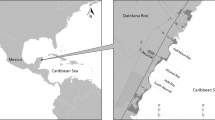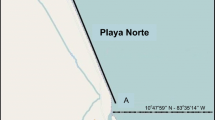Abstract
Olive ridley turtles (Lepidochelys olivacea) have two distinct mating systems: independent (solitary) and synchronized and mass assemblages (arribadas). Arribada nesting beaches have been the focus of most research, even though solitary nesting is the most common behavior. The purpose of this study was to assess the contribution of solitary nesting turtles to the olive ridley turtle population. We studied the nesting ecology of solitary nesting olive ridley turtles within the national park Parque Nacional Marino Las Baulas (PNMB) in Playa Grande, Costa Rica (10°20′N, 85°51′W) and compared these turtles to nearby arribada turtles. Between 2009/2010 and 2013/2014, an estimated 933 nesting activities occurred within PNMB. This number of turtles has not changed significantly since 1995. During this study, 285 females were tagged; of these, 30 females were encountered nesting on more than one occasion. Significantly, more females emerged (31.1 % of tracks) during the third-quarter moon, often a predictor of arribada events, than any other moon phase. However, there was no significant change in nesting activity at PNMB during nearby arribada events. Mean hatching success (78.5 ± 23.4 % SD) was higher, and incubation temperatures were lower (ranging from 28.3 to 33.4 °C) than at nearby arribada beaches. Thus, clutches are relatively successful and may produce males. These data suggest that solitary olive ridley turtles are important. Currently, PNMB protects turtles from October to March; however, hatching success was highest and 40 % of nesting activity occurred during the rainy season (August–November). More turtles could be protected by increasing the temporal scope of park protection.






Similar content being viewed by others
References
Bell BA, Spotila JR, Paladino FV, Reina RR (2003) Low reproductive success of leatherback turtles, Dermochelys coriacea, is due to high embryonic mortality. Biol Conserv 115:131–138
Bernardo J, Plotkin PT (2007) An evolutionary perspective on the arribada phenomenon and reproductive behavioral polymorphism of olive ridley sea turtles (Lepidochelys olivacea). In: Plotkin PT (ed) Biology and conservation of ridley sea turtles. The John’s Hopkins University Press, Maryland, pp 59–87
Binckley CA, Spotila JR, Wilson KS, Paladino FV (1998) Sex determination and sex ratios of Pacific leatherback turtles Dermochelys coriacea. Copeia 2:291–300
Blanco GS, Morreale SJ, Vélez E, Piedra R, Montes WM, Paladino FV, Spotila JR (2012) Reproductive output and ultrasonography of an endangered population of East Pacific green turtles. J Wildl Manage 76(4):841–846
Clusella Trullas S, Paladino FV (2007) Micro-environment of olive ridley turtle nests deposited during an aggregated nesting event. J Zool 272:367–376
Cornelius SE (1976) Marine turtle nesting activity at Playa Naranjo, Costa Rica. Department of Wildlife and Fisheries Sciences. Texas A&M University, College Station, pp 1–25
Eckrich CE, Owens DW (1995) Solitary versus arribada nesting in the olive ridley sea turtles (Lepidochelys olivacea): a test of the predator-satiation hypothesis. Herpetologica 51(3):349–354
Eguchi T, Gerrodette T, Pitman RL, Seminoff JA, Dutton PH (2007) At-sea density and abundance estimates of the olive ridley turtle Lepidochelys olivacea in the eastern tropical Pacific. Endanger Species Res 3:191–203
Fonseca LG, Murillo GA, Guadamúz L, Spínola RM, Valverde RA (2009) Downward but stable trend in the abundance of arribada olive ridley sea turtles (Lepidochelys olivacea) at Nancite Beach, Costa Rica (1971–2007). Chelonian Conserv Biol 8(1):19–27
Frick J (1976) Orientation and behaviour of hatchling green sea turtles (Chelonia mydas) in the sea. Anim Behav 24:849–857
García A, Ceballos G, Adaya R (2003) Intensive beach management as an improved sea turtle conservation strategy in Mexico. Biol Conservat 111:253–261
Hamel MA, McMahon CR, Bradshaw CJA (2008) Flexible inter-nesting behavior of the generalist olive ridley in Australia. J Exp Mar Biol Ecol 359:47–54
Hays GC, Broderick AC, Glen F, Godley BJ, Houghton JDR, Metcalfe JD (2002) Water temperature and internesting intervals for loggerhead (Caretta caretta) and green (Chelonia mydas) sea turtles. J Therm Biol 27:429–432
Hinestroza LM, Páez VP (2000) Anidación y manejo de la tortuga golfina (Lepidochelys olivacea) en la Playa la Cuevita, Bahía Solanon, Chocó, Colombia. Cuad Herpetol 14(2):131–144
Honarvar S, O’Connor MP, Spotila JR (2008) Density-dependent effects on hatching success of the olive ridley turtle, Lepidochelys olivacea. Oecologia 157:221–230
Hughes DA, Richard JD (1974) The nesting of the pacific ridley turtle Lepidochelys olivacea on Playa Nancite, Costa Rica. Mar Biol 24:97–107
James PSBR, Rajagopalan M, Dan SS, Bastian Fernando A, Selvaraj V (1991) Observations on mass nesting of the olive ridley Lepidochelys olivacea at Gahirmatha, Orissa during the 1987 season. J Mar Biol Associated India 33:69–75
Jensen MP, Abreu-Grobois FA, Frydenberg J, Loeschcke V (2006) Microsatellites provide insight into contrasting patterns in arribada vs. non-arribada olive ridley sea turtle rookeries. Mol Ecol 15:2567–2575
Kalb HJ (1999) Behavior and physiology of solitary and arribada nesting olive ridley sea turtles (Lepidochelys olivacea) during the internesting period. Dissertation, Texas A&M University, College Station, TX
López-Castro MC, Carmona R, Nichols WJ (2004) Nesting characteristics of the olive ridley turtle (Lepidochelys olivacea) in Cabo Pulmo, southern Baja California. Mar Biol 145:811–820
Márquez MR, Van Dissel HG (1982) A method for evaluating the number of massed nesting olive ridley sea turtles, Lepidochelys olivacea, during an arribazón, with comments on arribazón behaviour. Neth J Zool 32(3):419–425
Matos L, Silva ACCD, Castilhos JC, Weber MI, Soares LS, Vicente L (2012) Strong site fidelity and longer internesting interval for solitary nesting olive ridley sea turtles in Brazil. Mar Biol 159:1011–1019
Miller JD (1997) Reproduction in sea turtles. In: Lutz PL, Musick JA (eds) The biology of sea turtles. CRC Press, Boca Raton, pp 51–81
Miller JD (1999) Determining clutch size and hatching success. In: Eckert KL, Bjorndal KA, Abreu-Grobois FA, Donnelly M (eds) Research and management techniques for the conservation of sea turtles. IUCN/SSC Marine Turtle Specialist Group Publication No. 4, pp 124–129
Morreale SJ, Ruiz GJ, Spotila JR, Standora EA (1982) Temperature-dependant sex determination: current practices threaten conservation of sea turtles. Science 216:1245–1247
National Aeronautics and Space Administration. NASA Eclipse Web Site. http://eclipse.gsfc.nasa.gov/phase/phase2001gmt.html. Accessed March 2014)
Ocana M, Harfush-Melendez M, Heppell SS (2012) Mass nesting of olive ridley sea turtles (Lepidochelys olivacea) at La Escobilla, Mexico: linking nest density and rates of destruction. Endanger Species Res 16:45–54
Plotkin PT (2007) Olive ridley sea turtle (Lepidochelys olivacea) 5-year review: Summary and Evaluation. National Marine Fisheries Service Office of Protected Resources Silver Spring, Maryland and U.S. Fish and Wildlife Service Southeast Region Jacksonville Ecological Services Field Office Jacksonville, Florida. August 2007, pp 1–67
Plotkin PT (2010) Nomadic behaviour of the highly migratory olive ridley sea turtle Lepidochelys olivacea in the eastern tropical Pacific Ocean. Endanger Species Res 13:33–40
Plotkin PT, Byles RA, Rostal DC, Owens DW (1995) Independent versus socially facilitated oceanic migrations of the olive ridley, Lepidochelys olivacea. Mar Biol 122:137–143
Plotkin PT, Rostal DC, Byles RA, Owens DW (1997) Reproductive and developmental synchrony in female Lepidochelys olivacea. J Herpetol 30(1):17–22
Pritchard PCH (1969) Studies of the systematics and reproduction of the genus Lepidochelys. Dissertation, University of Florida, Gainsville, FL
Reina RD, Mayor PA, Spotila JR, Piedra R, Paladino FV (2002) Nesting ecology of the leatherback turtle, Dermochelys coriacea, at Parque Nacional Marino las Baulas, Costa Rica: 1988–1989 to 1999–2000. Copeia 3:653–664
Robinson NJ, Valentine SE, Santidrián Tomillo P, Saba VS, Spotila JR, Paladino FV (2014) Multidecadal trends in the nesting phenology of Pacific and Atlantic leatherback turtles are associated with population demography. Endanger Species Res 24:197–206
Santidrián Tomillo P, Suss JS, Wallace BP, Magrini KD, Blanco G, Paladino FV, Spotila JR (2009) Influence of emergence success on the annual reproductive output of leatherback turtles. Mar Biol 156:2021–2031
Santidrián Tomillo P, Paladino FV, Suss JS, Spotila JR (2010) Predation of leatherback turtle hatchlings during the crawl to the water. Chelonian Conserv Biol 9(1):18–25
Santidrián Tomillo P, Roberts SA, Hernández R, Spotila JR, Paladino FV (2014) Nesting ecology of East Pacific green turtles at Playa Cabuyal, Gulf of Papagayo, Costa Rica. Mar Ecol pp 1–11. doi:10.1111/maec.12159
Shanker K, Pandav B, Choudhury BC (2003) An assessment of the olive ridley turtle (Lepidochelys olivacea) nesting population in Orissa, India. Biol Conserv 115:149–160
Silva ACCD, Castilhos JC, Lopez GG, Barata PCR (2007) Nesting biology and conservation of the olive ridley sea turtle (Lepidochelys olivacea) in Brazil, 1991/1992 to 2002/2003. J Mar Biol Assoc UK 87:1047–1056
Spotila JR, Reina RD, Steyermark AC, Plotkin PT, Paladino FV (2000) Pacific leatherback turtles face extinction. Nature 405:529–530
Tripathy B (2008) An assessment of solitary and arribada nesting of olive ridley sea turtles (Lepidochelys olivacea) at the Rushikulya rookery of Orissa, India. Asiatic Herpetol Res 11:136–142
Tripathy B, Pandav B (2007) Beach fidelity and internesting movements of olive ridley turtles (Lepidochelys olivacea) at Rushikulya, India. Herpetol Conserv Biol 3(1):40–45
Tucker A (2010) Nest site fidelity and clutch frequency of loggerhead turtles are better elucidated by satellite telemetry than by nocturnal tagging efforts: implications for stock estimation. J Exp Mar Biol Ecol 383(1):48–55
Valverde RA, Wingard S, Gómez F, Tordoir MR, Orrego CM (2010) Field lethal incubation temperature of olive ridley sea turtle Lepidochelys olivacea embryos at a mass nesting rookery. Endanger Species Res 12:77–86
Valverde RA, Orrego CM, Tordoir MT, Gómez FM, Solís DS, Hernández RA, Gómez GB, Brenes LS, Baltodano JP, Fonseca LG, Spotila JR (2012) Olive ridley mass nesting ecology and egg harvest at Ostional Beach, Costa Rica. Chelonian Conserv Biol 11(1):1–11
Wallace BP, Kilham SS, Paladino FV, Spotila JR (2006) Energy budget calculations indicate resource limitation in Eastern Pacific leatherback turtles. Mar Ecol Prog Ser 318:263–270
Whiting SD, Long JL, Hadden KM, Lauder ADK, Koch AU (2007a) Insights into size, seasonality and biology of a nesting population of the olive ridley turtle in northern Australia. Wildlife Res 34(3):200–210
Whiting SD, Long JL, Coyne M (2007b) Migration routes and foraging behaviour of olive ridley turtles Lepidochelys olivacea in northern Australia. Endanger Species Res 3:1–9
Wibbles T, Rostal D, Byles R (1998) High pivotal temperature in the sex determination of the olive ridley sea turtle, Lepidochelys olivacea, from Playa Nancite, Costa Rica. Copeia 4:1086–1088
Acknowledgments
We would like to thank R. Valverde, F. Arroyo, C. Figgener, L. Fonseca, and C. M. Orrego for generously sharing data. The manuscript greatly benefited from the insightful comments of J. Houghton, K. Shanker, and an anonymous reviewer. Funding was provided by the Jack W. Schrey Distinguished Professorship Grant, The Leatherback Trust, and the Earthwatch Institute. We are grateful for the help from numerous Earthwatch volunteers and Las Baulas project field assistants for help with data collection. J. Seminoff and NOAA provided metal tags. The study followed the protocols of the Purdue University Animal Care, and research permits were obtained from the Ministry of Environment and Energy of Costa Rica (MINAE).
Author information
Authors and Affiliations
Corresponding author
Additional information
Communicated by J. Houghton.
Rights and permissions
About this article
Cite this article
Dornfeld, T.C., Robinson, N.J., Tomillo, P.S. et al. Ecology of solitary nesting olive ridley sea turtles at Playa Grande, Costa Rica. Mar Biol 162, 123–139 (2015). https://doi.org/10.1007/s00227-014-2583-7
Received:
Accepted:
Published:
Issue Date:
DOI: https://doi.org/10.1007/s00227-014-2583-7




